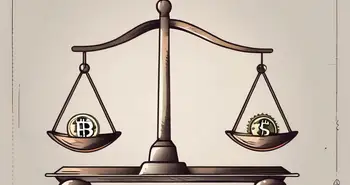Fiat vs Crypto: A Comprehensive Comparison

As an expert in the field of finance and cryptocurrency, I can confidently say that the ongoing debate between fiat currency and cryptocurrencies has become increasingly relevant in today's digital age. In this comprehensive comparison, I will shed light on the key features, advantages, and disadvantages of both fiat currency and cryptocurrencies to help you better understand these two distinct forms of value exchange.
Understanding Fiat Currency
Fiat currency represents the traditional form of money that has been in circulation for centuries. It is issued and regulated by the government, and its value is not backed by a physical commodity like gold or silver. Instead, the value of modern fiat currency is based on the trust and confidence of the public and the strength of the issuing government's economy.
The History of Fiat Money
Fiat money has a long and complex history. It originated as a way for governments to simplify trade and eliminate the need for bartering. In ancient times, various forms of fiat currency were introduced, such as clay tablets and metal coins. Over time, paper money became the primary form of fiat currency, and it continues to be widely used today.
During the Tang Dynasty in China, the first known paper money, known as “jiaozi,” was introduced. It was made from the bark of mulberry trees and had intricate designs to prevent counterfeiting. The use of paper money spread throughout Asia and eventually reached Europe in the 13th century. The Bank of Stockholm in Sweden issued the first European banknotes in 1661, which were fully backed by copper plates.
Key Features of Fiat Currency
One of the key features of fiat currency is its widespread acceptance as legal tender within a specific country or region. It is recognized as the official medium of exchange for goods and services, and its value is controlled by the central bank or government. Additionally, fiat currency provides a stable means of exchange and serves as a unit of account, allowing for easy comparison of prices.
Moreover, fiat currency offers a level of flexibility that other forms of money may lack. It can be easily divided into smaller denominations, making it suitable for various transaction sizes. This divisibility allows for the efficient exchange of goods and services, contributing to the overall economic growth of a nation.
Pros and Cons of Fiat Money
Fiat currency has several advantages. Its widespread acceptance makes it highly convenient for everyday transactions, and it is typically insured by the government, providing a level of security. Furthermore, the stability of fiat currency allows for long-term financial planning and investment.
On the other hand, there are some drawbacks to fiat currency. The value of fiat money can be affected by inflation, which erodes its purchasing power over time. Additionally, the centralized control of fiat currency can lead to potential manipulation by governments or central banks, causing economic instability.
Despite these challenges, fiat currency continues to be the primary form of money used globally. Its adaptability and widespread acceptance have made it an integral part of modern economies, facilitating trade and economic growth.
Unraveling Cryptocurrency
Cryptocurrency, on the other hand, is a digital form of currency that operates independently of governments and central banks. It is based on blockchain technology, which ensures transparency and security in transactions. Cryptocurrencies like Bitcoin and Ethereum have gained significant attention and popularity in recent years.
The Birth of Cryptocurrency
The concept of cryptocurrency was first introduced by an anonymous person or group known as Satoshi Nakamoto in 2008. The release of Bitcoin in 2009 marked the beginning of a new era in economics and finance. Cryptocurrencies are created through complex mathematical algorithms and are stored in digital wallets, making them highly secure.
Key Characteristics of Cryptocurrencies
Cryptocurrencies possess several unique characteristics. Firstly, they are decentralized, meaning that no central authority controls the supply or value of the currency. Transactions are verified by a network of computers, making them transparent and resistant to fraud. Additionally, cryptocurrencies offer fast and efficient cross-border transactions at a lower cost compared to traditional banking systems.
Advantages and Disadvantages of Cryptocurrency
Cryptocurrency offers numerous advantages. It provides individuals with greater financial autonomy and control over their funds, as transactions can be made without the need for intermediaries such as banks. Cryptocurrencies also enable financial inclusion for the unbanked population, particularly in developing countries.
However, cryptocurrencies are not without their challenges. The volatility of cryptocurrency prices can pose risks for investors, as their values can fluctuate significantly in short periods of time. Furthermore, the decentralized nature of cryptocurrencies makes them attractive to criminals for money laundering and illegal activities.
Fiat and Crypto: A Side-by-Side Comparison
Now that we have examined the fundamental aspects of both fiat currency and cryptocurrencies, let us compare the two in essential areas.
Comparing Security: Fiat vs Crypto
When it comes to security, both fiat currency and cryptocurrencies have their strengths and weaknesses. Fiat currency benefits from the backing and enforcement of governments and central banks, providing a certain level of trust and stability. However, it is susceptible to counterfeiting, theft, and fraud.
On the other hand, cryptocurrencies utilize advanced cryptographic algorithms and decentralized networks to ensure secure transactions. While the systems may be very secure, the vulnerability lies in the personal responsibility of safeguarding private keys and digital wallets from hackers.
Accessibility and Usability: A Comparative Analysis
In terms of accessibility and usability, fiat currency holds a clear advantage. It is universally accepted and used by governments, institutions, and most individuals. You can easily use fiat currency everywhere, from local grocery stores to international travel destinations.
Cryptocurrencies, while gaining popularity, still face limitations in acceptance. It is not yet widely adopted, and only a limited number of businesses and merchants accept digital currencies as a form of payment. However, there is a growing trend of acceptance in specific industries and regions.
Stability and Volatility: Fiat Money and Cryptocurrency
Stability and volatility are two crucial factors that differentiate fiat currency from cryptocurrencies. Fiat currency is generally more stable due to the control exerted by governments and central banks. Changes in value are usually gradual, allowing individuals and businesses to plan their finances effectively.
On the other hand, cryptocurrencies are known for their volatility. Prices can fluctuate significantly within minutes or hours, creating opportunities for profits but also risks. This volatility is attributed to various factors, including market speculation, regulatory changes, and technological advancements.
The Role of Government and Regulation
The role of government and regulation differs significantly between fiat currency and cryptocurrencies.
Government Control in Fiat Currency
Fiat currency is directly controlled by governments and central banks. They have the authority to determine the supply, interest rates, and other monetary policies that impact the economy. Governments also have the power to introduce and enforce regulations to ensure the stability and integrity of the fiat currency system.
The Regulatory Landscape for Cryptocurrencies
Cryptocurrencies, being decentralized and independent of government control, pose a unique challenge for regulators. Different countries have taken varied approaches to the regulation of cryptocurrencies, ranging from outright bans to embracing and fostering innovation.
The regulatory landscape is continually evolving as governments seek to strike a balance between consumer protection, monetary stability, and financial innovation. Regulations aim to combat illicit activities, promote investor confidence, and establish a framework for the future of cryptocurrencies.
Overall, both fiat currency and cryptocurrencies have their own advantages and disadvantages. The decision on which form of currency to use ultimately depends on individual preferences, needs, and risk tolerance.
FAQ
What is fiat currency?
Fiat currency is the traditional form of money issued and regulated by the government, without physical commodity backing. It is widely accepted and has stability and convenience benefits.
What are the advantages of fiat money?
Some advantages of fiat currency include widespread acceptance, stability for financial planning, and government-backed security.
What is cryptocurrency?
Cryptocurrency is a digital form of currency that operates independently of governments and central banks. It utilizes blockchain technology for secure and transparent transactions.
What are the advantages of cryptocurrency?
Cryptocurrency offers advantages such as financial autonomy, fast cross-border transactions, and increased financial inclusion.
What are the differences between fiat currency and cryptocurrency?
Fiat currency is centralized, controlled by governments, and widely accepted. Cryptocurrency is decentralized, independent of government control, and offers secure and efficient transactions.
How do governments regulate fiat currency and cryptocurrencies?
Governments control fiat currency through monetary policies and regulations. The regulation of cryptocurrencies varies among countries, aiming to strike a balance between consumer protection and fostering innovation.
Which currency is right for me?
The choice between fiat currency and cryptocurrency depends on your preferences, needs, and risk tolerance. Consider factors such as stability, accessibility, and regulatory frameworks when making your decision.
In conclusion, the debate between fiat currency and cryptocurrency continues to shape the future of financial systems. Both have their merits and peculiarities, and as the world becomes more digitized, understanding the intricacies of these two forms of value exchange is indispensable for thriving in the evolving economic landscape.
Now that you've explored the nuances of fiat and cryptocurrency, why not take your understanding to the next level with Morpher? As a platform at the forefront of financial innovation, Morpher.com offers you the unique opportunity to trade across a multitude of asset classes with zero fees, infinite liquidity, and the safety of a non-custodial wallet. Whether you're interested in traditional markets or the exciting world of NFTs and cryptocurrencies, Morpher caters to all your trading desires. Embrace the future of investing with fractional shares, short selling, and up to 10x leverage. Ready to dive in? Sign Up and Get Your Free Sign Up Bonus today, and experience a trading platform that's as dynamic and versatile as the ever-evolving landscape of fiat and crypto.

Disclaimer: All investments involve risk, and the past performance of a security, industry, sector, market, financial product, trading strategy, or individual’s trading does not guarantee future results or returns. Investors are fully responsible for any investment decisions they make. Such decisions should be based solely on an evaluation of their financial circumstances, investment objectives, risk tolerance, and liquidity needs. This post does not constitute investment advice.

Painless trading for everyone
Hundreds of markets all in one place - Apple, Bitcoin, Gold, Watches, NFTs, Sneakers and so much more.

Painless trading for everyone
Hundreds of markets all in one place - Apple, Bitcoin, Gold, Watches, NFTs, Sneakers and so much more.









